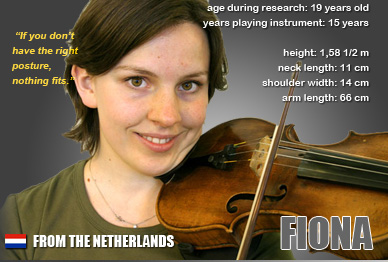3. Making the change
Things I never knew
Everything was new to me. I certainly never knew that your chin rest and shoulder rest would have so much influence on the way you play! I am not very tall, and my arms are short, so I needed the violin more in front to bow easily, yet my neck is long, so I needed a chin rest to suit it.
Before the project I didnít know that my neck was long. I didnít really know it was that important. I never thought, ďOh that guy has a really long neck, he probably has trouble playing the violin.Ē Now I think: if I didnít have a chin rest where would I be? Iíd have to play with my neck all crooked! That is the reason that people put chin rest or shoulder rest on in the first place: to help them to play comfortably. You just need the support from your violin that a good chin rest and shoulder rest provides.
Equipment changes
Shoulder rest
The first thing I changed was the shoulder rest. The shoulder rest I had been using was sitting on top of my shoulder joint and therefore blocking my left arm.
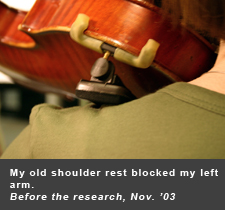
After trying an awful lot of things that were either too close to my neck or too far away, I decided to buy the play-on-air shoulder rest cushion. It sits on top of the shoulder joint a little bit but is made out of a light material so it doesnít press on it.
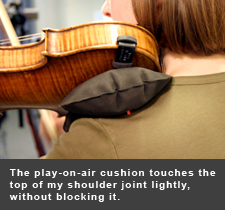
The only problem about the play-on-air is that there is a slight dent in the cushion right where I needed support, but I filled that up with half of a red ďEprexĒ ball. In this way the cushion stayed in the right place instead of sliding off my shoulder.
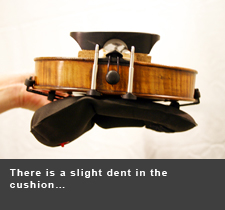
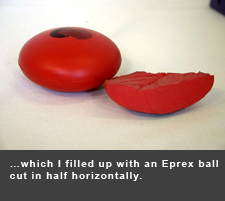
But after awhile the half ball was pressing on my chest muscle, blocking my left arm from moving freely, which made it more difficult for me to go up in higher positions. It also took even more sound away from the violin than the play-on-air already did. So after a few months, I just took off the ball to see how it would work, and it worked. I was not expecting it to work, but then I thought, ďOh, it doesnít make all that much difference and it makes my arm feel freer.Ē
I think that I could do without the support of the ball at this point because I had developed more structure in my body itself. Before, I used to push my left shoulder up a bit when I played. My shoulder automatically contracted. That got less during the research. Now I know how to use my left arm for vibrato without tightening the muscles in my shoulder. I also knew that I could always put the ball back if I needed to. I had something to fall back on. I had that in the back of my mind all the time, which was reassuring.
Chin Rest
Another problem was my chin rest. In order to put my chin on my chin rest I had to bend my neck and bring my head down quite far, so we made the chin rest 8mm higher. We also moved it to the middle, over the tailpiece, instead of having it over to the left. This puts the violin in the right position for my arms. I am able to reach closer to the tip of the bow without over-stretching my right shoulder.
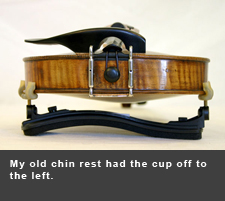
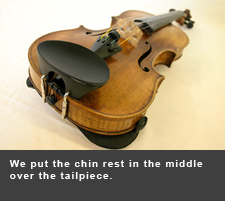
Violin
I also decided to change to a different violin. I used to have a full size violin and now I have a 7/8, which suits my size better.
Changes in playing technique
Holding the violin: I am the structure
I used to pull my head down to the left a lot, because my chin rest was much lower than it is now. Now I think my head is very straight when I play. And that is quite an important thing. Because I am not pushing my head down so much I am able to relax the muscles in my neck more. I am also more aware of the balance you need to have between your left hand and your neck. Some people think you have to hold your violin with your head and then drop your arm completely and still keep the violin up. But that way you are using your neck too much which causes tension there. But if you are not using your neck at all, then you are using your arm too much to lift the violin, which causes tension in your arms. Both things arenít quite right.
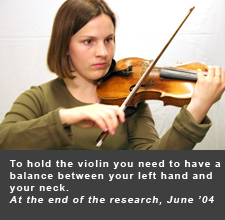
I think you have to find something in between. You have to find a kind of a balance where you are comfortable and you are still free. When shifting down, for instance, then you just need to secure the violin with your head a little bit more. You support the violin with your head a little bit so that your violin doesnít slide away, but you are not actually pushing your head down so hard that you cannot move it anymore. This is what I do now, which is very different than before.
Bow arm: the power comes from your back
My bowing has changed. I can now reach the tip of the bow, because the chin rest is in the middle now, which changes the violin position. Also, when my bow is resting on the strings it is just straighter. I donít have to push my bow arm away from my body to be able to bow straight. I can keep my upper arm more next to me.
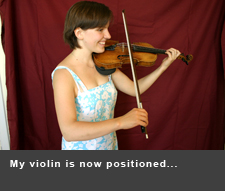
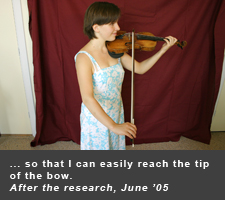
I used to push down with my arm to bow. I thought that I was using the weight of my arm, but I was just pushing down. In my Alexander Technique lessons I learned to think of my head; to think of it being more up, of myself as lighter. If you think yourself heavy all the time, you tend to drive yourself into the ground, literally! I also learned how to get that feeling of width in my back and also in the front. All this just makes me freer and lighter.
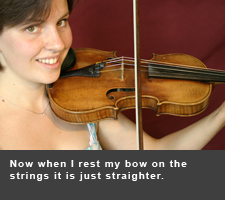
If you push your arm down to bow you think you will get more sound out if it, but in the long run you donít. And if you think light, that doesnít mean you canít use the weight of your arm. It just means that you remain active and use the natural weight of your arm directed into the string.
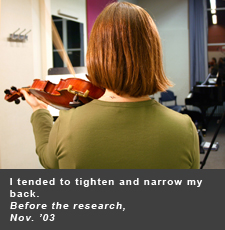
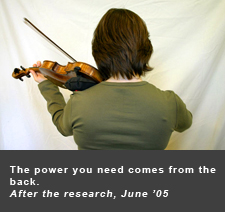
Other people noticed a big difference in my sound. I didnít notice that myself at first because I was so busy with how it all felt. I realize now that when I am playing, I know what to do, which muscles to use. I let the weight of my arm do the work instead of pushing it myself. It helps to stand in a stable way, with two feet on the ground. It is important to know how your back works. The power you need comes from the back.

